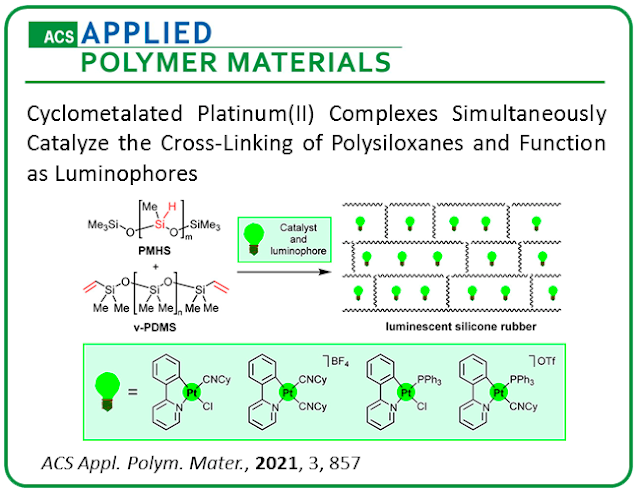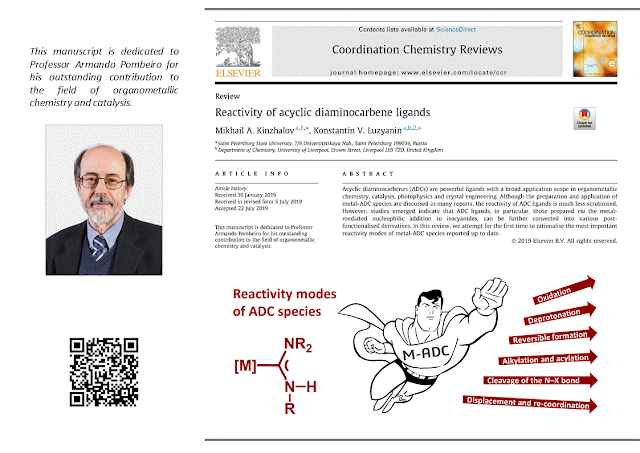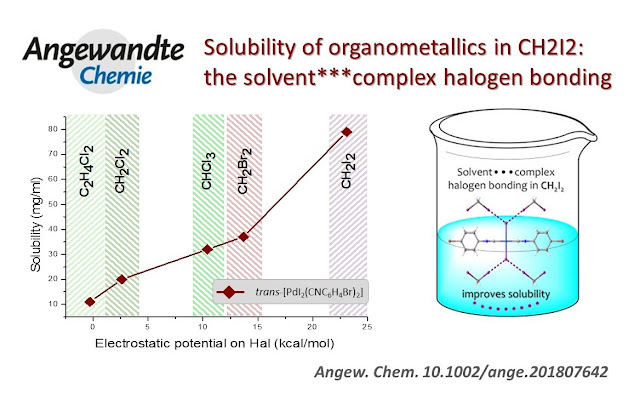Cyclometalated Platinum(II) Complexes Simultaneously Catalyze and Function as Luminophores
Cyclometalated Platinum(II) Complexes Simultaneously Catalyze the Cross-Linking of Polysiloxanes and Function as Luminophores

Full text: ACS Appl. Polym. Mater., 2021, 3, 857
Write for free PDF

A family of the C,N-cyclometalated species [Pt(ppy)Cl(PPh3)], [Pt(ppy)Cl(CNCy)], [Pt(ppy)(CNCy)(PPh3)](OTf), and [Pt(ppy)(CNCy)2](BF4) (ppy = 2-phenylpyridinato-C2,N; Cy = cyclohexyl) was generated from [Pt(ppy)(μ-Cl)]2, CNCy, and PPh3. The obtained platinum(II) complexes were characterized by high-resolution ESI+-MS, IR, and 1D (1H, 13C{1H}, 195Pt{1H}) and 2D (1H,1H-NOESY; 1H,13C-HSQC; 1H,13C-HMBC) NMR spectroscopy, and the latter three complexes were investigated by X-ray diffraction. All four platinum species were examined as hydrosilylation catalysts (c 10–4–10–3 M; 80–120 °C; [Pt(ppy)Cl(PPh3)] exhibited the highest catalytic activity) for the cross-linking of vinyl-terminated polydimethylsiloxane and polymethylhydrosiloxane to achieve luminescent silicone rubbers. Each solid complex and the appropriate silicone rubber exhibited the same emission spectra in the green region and strong phosphorescence with a solid-state quantum yield of up to 12.5% (measured for the silicone elastomer obtained with the [Pt(ppy)(CNCy)2](BF4) catalyst). The resulting luminescent silicone rubbers can be potentially used for protective coatings (to facilitate the thickness control) and as a component for phosphor-converted white light-emitting diodes (to transform a UV part of the LED emission to the visible spectrum).




A family of the C,N-cyclometalated species [Pt(ppy)Cl(PPh3)], [Pt(ppy)Cl(CNCy)], [Pt(ppy)(CNCy)(PPh3)](OTf), and [Pt(ppy)(CNCy)2](BF4) (ppy = 2-phenylpyridinato-C2,N; Cy = cyclohexyl) was generated from [Pt(ppy)(μ-Cl)]2, CNCy, and PPh3. The obtained platinum(II) complexes were characterized by high-resolution ESI+-MS, IR, and 1D (1H, 13C{1H}, 195Pt{1H}) and 2D (1H,1H-NOESY; 1H,13C-HSQC; 1H,13C-HMBC) NMR spectroscopy, and the latter three complexes were investigated by X-ray diffraction. All four platinum species were examined as hydrosilylation catalysts (c 10–4–10–3 M; 80–120 °C; [Pt(ppy)Cl(PPh3)] exhibited the highest catalytic activity) for the cross-linking of vinyl-terminated polydimethylsiloxane and polymethylhydrosiloxane to achieve luminescent silicone rubbers. Each solid complex and the appropriate silicone rubber exhibited the same emission spectra in the green region and strong phosphorescence with a solid-state quantum yield of up to 12.5% (measured for the silicone elastomer obtained with the [Pt(ppy)(CNCy)2](BF4) catalyst). The resulting luminescent silicone rubbers can be potentially used for protective coatings (to facilitate the thickness control) and as a component for phosphor-converted white light-emitting diodes (to transform a UV part of the LED emission to the visible spectrum).






